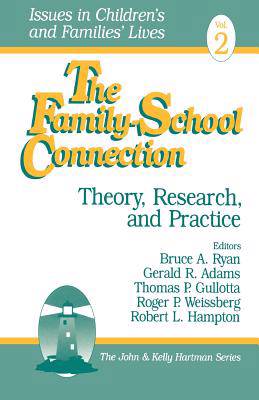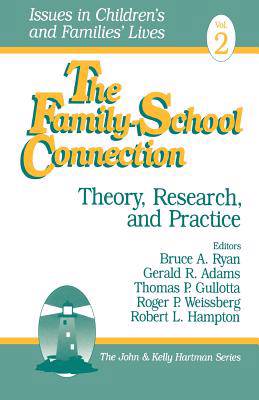
- Afhalen na 1 uur in een winkel met voorraad
- Gratis thuislevering in België vanaf € 30
- Ruim aanbod met 7 miljoen producten
- Afhalen na 1 uur in een winkel met voorraad
- Gratis thuislevering in België vanaf € 30
- Ruim aanbod met 7 miljoen producten
Zoeken
The Family-School Connection
Theory, Research, and Practice
€ 160,45
+ 320 punten
Omschrijving
Currently, only about 50% of American youths live in traditional two-parent, first-marriage families. This fact, combined with often bleak economic and social realities, creates the backdrop of interactions between families, children, and schools are examined in this probing volume. Answering a need for evaluative research in this area of increasing public interest, the contributors build a model for evaluation, focusing on the dynamics of family-school connections. How is school achievement influenced by parent-child interactions and the family environment? How do school, family, community, and peer-group connections affect early adolescents? What is the family′s role in the success of learning-disabled youth or in school truancy? What effect does parental discord and divorce have on a child′s learning? These questions, as well as proposals for intervention and prevention, create the crux of this book designed to inform and motivate readers to respond to one of our country′s most fundamental social concerns. Vital reading for everyone who wants to better understand child-school-community interaction, this book especially warrants reading by students, researchers, and other professionals in developmental psychology, family studies, psychology, and social work. "The book should be read by professionals who have contact with schools as part of their brief; by those educators who train the new generation of social workers, psychologists, and teachers; and by researchers who seek to understand the tapestry of social influences on children′s development. The book is worth buying alone for the fruits of great scholarship evident in the extensive lists of up-to-date references at the end of each chapter, and in a superb appendix that offers a tour de force of a 19-page bibliography on the topic." --Child and Family Social Work
Specificaties
Betrokkenen
- Uitgeverij:
Inhoud
- Aantal bladzijden:
- 384
- Taal:
- Engels
- Reeks:
Eigenschappen
- Productcode (EAN):
- 9780803973077
- Verschijningsdatum:
- 1/05/1995
- Uitvoering:
- Paperback
- Formaat:
- Trade paperback (VS)
- Afmetingen:
- 140 mm x 216 mm
- Gewicht:
- 485 g

Alleen bij Standaard Boekhandel
+ 320 punten op je klantenkaart van Standaard Boekhandel
Beoordelingen
We publiceren alleen reviews die voldoen aan de voorwaarden voor reviews. Bekijk onze voorwaarden voor reviews.










